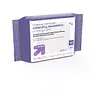What's inside
What's inside
 Key Ingredients
Key Ingredients

 Benefits
Benefits

 Concerns
Concerns

 Ingredients Side-by-side
Ingredients Side-by-side

Water
Skin ConditioningDicaprylyl Ether
EmollientDecyl Glucoside
CleansingGlyceryl Oleate
EmollientPhenoxyethanol
PreservativeBenzoic Acid
MaskingDehydroacetic Acid
PreservativeTetrasodium Glutamate Diacetate
Citric Acid
BufferingSodium Citrate
BufferingSodium Bicarbonate
AbrasiveTocopheryl Acetate
AntioxidantPanthenol
Skin ConditioningParfum
MaskingPunica Granatum Seed Oil
EmollientCocos Nucifera Oil
MaskingOlea Europaea Fruit Oil
MaskingArgania Spinosa Kernel Oil
EmollientSimmondsia Chinensis Seed Oil
EmollientPersea Gratissima Oil
Skin ConditioningOrbignya Oleifera Seed Oil
EmollientMoringa Oleifera Seed Oil
EmollientSalvia Hispanica Seed Oil
MoisturisingCrambe Abyssinica Seed Oil
Skin ConditioningWater, Dicaprylyl Ether, Decyl Glucoside, Glyceryl Oleate, Phenoxyethanol, Benzoic Acid, Dehydroacetic Acid, Tetrasodium Glutamate Diacetate, Citric Acid, Sodium Citrate, Sodium Bicarbonate, Tocopheryl Acetate, Panthenol, Parfum, Punica Granatum Seed Oil, Cocos Nucifera Oil, Olea Europaea Fruit Oil, Argania Spinosa Kernel Oil, Simmondsia Chinensis Seed Oil, Persea Gratissima Oil, Orbignya Oleifera Seed Oil, Moringa Oleifera Seed Oil, Salvia Hispanica Seed Oil, Crambe Abyssinica Seed Oil
Water
Skin ConditioningAloe Barbadensis Leaf Juice
Skin ConditioningGlycerin
HumectantGossypium Herbaceum Flower Extract
HumectantOryza Sativa Extract
AbsorbentArtemisia Umbelliformis Extract
Skin ConditioningBeta Vulgaris Root Extract
Skin ConditioningEuphrasia Officinalis Extract
AntimicrobialSaccharum Officinarum Extract
MoisturisingSucrose
HumectantFructose
HumectantGlucose
HumectantCaprylyl/Capryl Glucoside
CleansingDicaprylyl Carbonate
EmollientPolyglyceryl-4 Caprate
EmulsifyingXanthan Gum
EmulsifyingTocopherol
AntioxidantGlycine Soja Oil
EmollientTrehalose
HumectantCitric Acid
BufferingInositol
HumectantAlcohol Denat.
AntimicrobialBenzoic Acid
MaskingBenzyl Alcohol
PerfumingPotassium Sorbate
PreservativeSodium Benzoate
MaskingPhenoxyethanol
PreservativeWater, Aloe Barbadensis Leaf Juice, Glycerin, Gossypium Herbaceum Flower Extract, Oryza Sativa Extract, Artemisia Umbelliformis Extract, Beta Vulgaris Root Extract, Euphrasia Officinalis Extract, Saccharum Officinarum Extract, Sucrose, Fructose, Glucose, Caprylyl/Capryl Glucoside, Dicaprylyl Carbonate, Polyglyceryl-4 Caprate, Xanthan Gum, Tocopherol, Glycine Soja Oil, Trehalose, Citric Acid, Inositol, Alcohol Denat., Benzoic Acid, Benzyl Alcohol, Potassium Sorbate, Sodium Benzoate, Phenoxyethanol
 Reviews
Reviews

Ingredients Explained
These ingredients are found in both products.
Ingredients higher up in an ingredient list are typically present in a larger amount.
Benzoic Acid is used to preserve and adjust the pH of products.
The antimicrobial property of Benzoic Acid helps elongate a product's shelf life. Its main role is to reduce fungi growth and is not found to be effective at fighting bacteria. Therefore Benzoic Acid is always added along with other preservatives.
In its pure form, Benzoic Acid looks like a white crystalline solid. It has slight solubility in water.
The name of Benzoic Acid comes from gum benzoin, which used to be the sole source of deriving this ingredient. Benzoic Acid is the most simple aromatic carboxylic acid.
Benzoic Acid is naturally occuring in strawberries, mustard, cinnamon, and cloves. It has a slight scent but is not considered to be a fragrance.
Learn more about Benzoic AcidCitric Acid is an alpha hydroxy acid (AHA) naturally found in citrus fruits like oranges, lemons, and limes.
Like other AHAs, citric acid can exfoliate skin by breaking down the bonds that hold dead skin cells together. This helps reveal smoother and brighter skin underneath.
However, this exfoliating effect only happens at high concentrations (20%) which can be hard to find in cosmetic products.
Due to this, citric acid is usually included in small amounts as a pH adjuster. This helps keep products slightly more acidic and compatible with skin's natural pH.
In skincare formulas, citric acid can:
While it can provide some skin benefits, research shows lactic acid and glycolic acid are generally more effective and less irritating exfoliants.
Most citric acid used in skincare today is made by fermenting sugars (usually from molasses). This synthetic version is identical to the natural citrus form but easier to stabilize and use in formulations.
Read more about some other popular AHA's here:
Learn more about Citric AcidPhenoxyethanol is a preservative that has germicide, antimicrobial, and aromatic properties. Studies show that phenoxyethanol can prevent microbial growth. By itself, it has a scent that is similar to that of a rose.
It's often used in formulations along with Caprylyl Glycol to preserve the shelf life of products.
Water. It's the most common cosmetic ingredient of all. You'll usually see it at the top of ingredient lists, meaning that it makes up the largest part of the product.
So why is it so popular? Water most often acts as a solvent - this means that it helps dissolve other ingredients into the formulation.
You'll also recognize water as that liquid we all need to stay alive. If you see this, drink a glass of water. Stay hydrated!
Learn more about Water